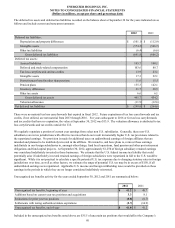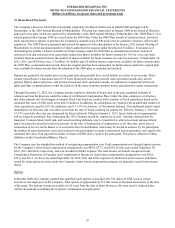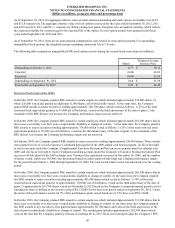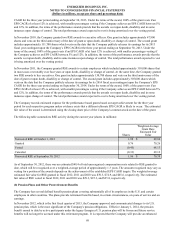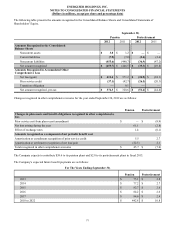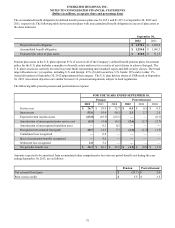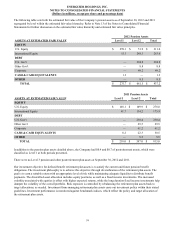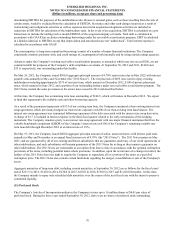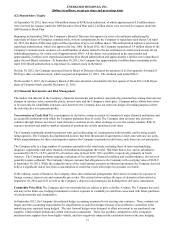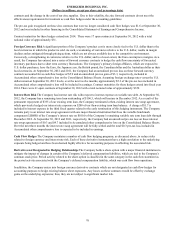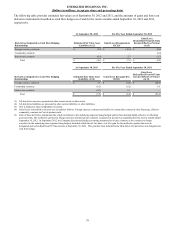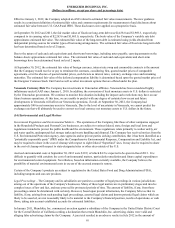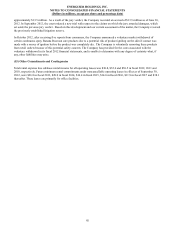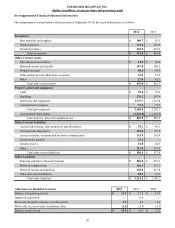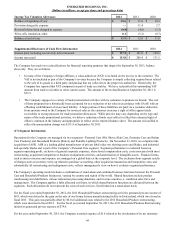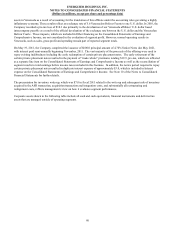Energizer 2012 Annual Report Download - page 85
Download and view the complete annual report
Please find page 85 of the 2012 Energizer annual report below. You can navigate through the pages in the report by either clicking on the pages listed below, or by using the keyword search tool below to find specific information within the annual report.
ENERGIZER HOLDINGS, INC.
(Dollars in millions, except per share and percentage data)
(9) Defined Contribution Plan
The Company sponsors a defined contribution plan, which extends participation eligibility to substantially all U.S. employees,
other than legacy ASR employees. The Company matches 50% of participant’s before-tax contributions up to 6% of eligible
compensation. Amounts charged to expense during fiscal 2012, 2011, and 2010 were $9.3, $9.2, and $8.0, respectively, and are
reflected in SG&A and Cost of products sold in the Consolidated Statements of Earnings, and Comprehensive Income. The
fiscal 2012 and 2011 expense amounts include $0.9 related to the matching components of two legacy ASR plans. These plans
were part of the ASR acquisition that occurred in early fiscal 2011.
(10) Debt
Notes payable at September 30, 2012 and 2011 consisted of notes payable to financial institutions with original maturities of
less than one year of $162.4 and $56.0, respectively, and had a weighted-average interest rate of 2.2% and 3.1%, respectively.
The detail of long-term debt at September 30 for the year indicated is as follows:
2012 2011
Private Placement, fixed interest rates ranging from 4.3% to 6.6%, due 2013 to 2017 $ 1,165.0 $ 1,265.0
Senior Notes, fixed interest rate of 4.7%, due 2021 600.0 600.0
Senior Notes, fixed interest rate of 4.7%, due 2022, net of discount 498.6 —
Term Loan, variable interest at LIBOR +63 basis points, or 0.9%, due December 2012 106.5 447.5
Total long-term debt, including current maturities 2,370.1 2,312.5
Less current portion 231.5 106.0
Total long-term debt $ 2,138.6 $ 2,206.5
The Company’s total borrowings were $2,532.5 at September 30, 2012, including $268.9 tied to variable interest rates, of
which $100 is hedged via the interest rate swap discussed below. The Company maintains total debt facilities of $2,982.5. The
Company's Amended and Restated Revolving Credit Agreement, which matures in 2016, currently provides for revolving credit
loans and the issuance of letters of credit in an aggregate amount of up to $450. We have no outstanding borrowings under our
revolving credit facility, and $438.9 remains available as of September 30, 2012, including $11.1 of outstanding letters of
credit.
Under the terms of the Company’s credit agreements, the ratio of the Company’s indebtedness to its earnings before interest
taxes depreciation and amortization (EBITDA), as defined in the agreements and detailed below, cannot be greater than 4.00 to
1, and may not remain above 3.50 to 1 for more than four consecutive quarters. If and so long as the ratio is above 3.50 to 1 for
any period, the Company is required to pay additional interest expense for the period in which the ratio exceeds 3.50 to 1. The
interest rate margin and certain fees vary depending on the indebtedness to EBITDA ratio. Under the Company’s private
placement note agreements, indebtedness to EBITDA may not be greater than 4.00 to 1; if the ratio is above 3.50 to 1, for any
quarter, the Company is required to pay additional interest on the private placement notes of 0.75% per annum for each quarter
until the ratio is reduced to not more than 3.50 to 1. In addition, under the credit agreements, the ratio of its current year
earnings before interest and taxes (EBIT), as defined in the agreements, to total interest expense must exceed 3.00 to 1. The
Company’s ratio of indebtedness to its EBITDA was 2.64 to 1, and the ratio of its EBIT to total interest expense was 5.86 to 1,
as of September 30, 2012. These ratios are impacted by pre-tax cash charges associated with restructuring activities as such
charges reduce both EBITDA and EBIT as defined in the agreements. The ratios at September 30, 2012 did not include material
restructuring charges. However, these ratios will be negatively impacted in the next two fiscal years as we execute our recently
announced restructuring plan in fiscal 2013 and 2014. In addition to the financial covenants described above, the credit
agreements and the note purchase agreements contain customary representations and affirmative and negative covenants,
including limitations on liens, sales of assets, subsidiary indebtedness, mergers and similar transactions, changes in the nature
of the business of the Company and transactions with affiliates. If the Company fails to comply with the financial covenants
referred to above or with other requirements of the credit agreements or private placement note agreements, the lenders would
have the right to accelerate the maturity of the debt. Acceleration under one of these facilities would trigger cross defaults on
other borrowings.
Under the credit agreements, EBITDA is defined as net earnings, as adjusted to add-back interest expense, income taxes,
depreciation and amortization, all of which are determined in accordance with GAAP. In addition, the credit agreement allows
certain non-cash charges such as stock award amortization and asset write-offs or impairments to be “added-back” in
75


